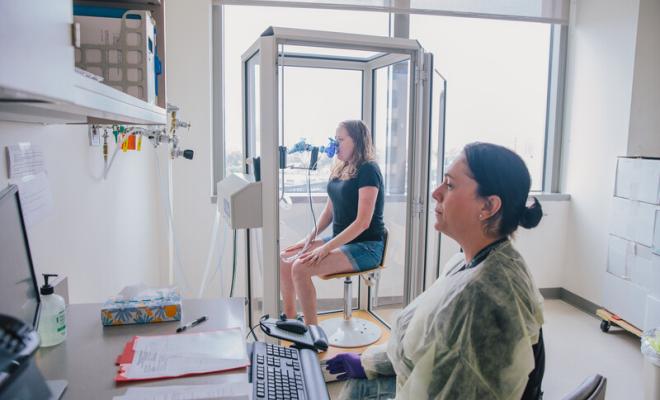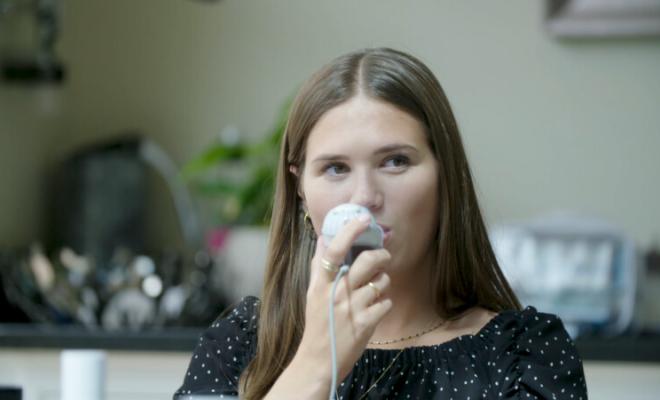Pneumothorax and Hemoptysis Clinical Care Guidelines
Flume PA, Mogayzel PJ, Robinson KA, et al. Cystic Fibrosis Pulmonary Guidelines: Pulmonary Complications: Hemoptysis and Pneumothorax. Am J Respir Crit Care Med. 2010 Aug 1;182(3):298-306. doi: 10.1164/rccm.201002-0157CI.PMID: 20675678.
Purpose and Background
The Cystic Fibrosis Foundation Pulmonary Therapies Committee recognized that insufficient data existed to develop evidence-based recommendations. The Delphi process was used to formalize an expert panel's consensus and develop explicit care recommendations. These guidelines were designed to answer common questions encountered in the management of people with cystic fibrosis with hemoptysis and pneumothorax.
The committee noted that the guidelines were designed for general application in most individuals, but should be adapted to meet the specific needs of individual patients. Updated publications relevant to the management of hemoptysis and pneumothorax in CF are reviewed below, with citations listed in the further reading section.
Methodology
A multidisciplinary committee was assembled to perform a literature search and develop specific questions regarding the management of pneumothorax and hemoptysis in people with CF. A separate expert panel composed of CF clinicians, interventional radiologists, and lung transplantation surgeons was selected by committee members to complete the survey questions, rating the appropriateness of each statement using a Likert scale. Delphi methodology was used to quantify group consensus. Numeric responses to the questions were summarized and applied to a priori definitions to determine levels of consensus. The expert panel completed the survey twice, allowing refinement of recommendations.
Hemoptysis Definitions
- Massive hemoptysis: >240 mililiters (ml)
- Mild to moderate hemoptysis: 5-240 ml
- Scant hemoptysis: <5 ml
Hemoptysis Recommendations |
|
| When should the patient with hemoptysis contact their health care provider? | |
| Recommendations | Evaluation of the Evidence |
| 1. The patient with scant hemoptysis should contact their health care provider if it is the first-ever episode, or if it is persistent. |
Delphi |
| 2. The patient with at least mild hemoptysis should contact their health care provider. |
Delphi |
|
When should the patient with hemoptysis be admitted to the hospital? |
|
| Recommendations | Evaluation of the Evidence |
| 3. The patient with scant hemoptysis may not require admission to the hospital. | Delphi |
| 4. The patient with massive hemoptysis should always be admitted to the hospital. | Delphi |
| When should the patient with hemoptysis be treated with antibiotics? | |
| Recommendations | Evaluation of the Evidence |
| 5. The patient with scant hemoptysis but without signs of a pulmonary exacerbation may not need antibiotics. | Consensus was not sufficient to make a definitive recommendation |
| 6. The patient with at least mild hemoptysis should be treated with antibiotics. | Delphi |
| Should the patient with hemoptysis stop nonsteroidal anti-inflammatory drugs (NSAIDS)? | |
| Recommendations | Evaluation of the Evidence |
| 7. For patients with scant hemoptysis, there was moderate consensus that NSAIDS should be stopped. | Consensus was not sufficient to make a definitive recommendation |
| 8. The patient with at least mild hemoptysis should stop NSAIDS. | Delphi |
| Which patients should undergo bronchial artery embolization (BAE)? | |
| Recommendations | Evaluation of the Evidence |
| 9. The patient with massive hemoptysis who is clinically unstable should be treated with BAE. | Delphi |
| Which studies should be performed in patients before BAE? | |
| Recommendations | Evaluation of the Evidence |
| 10. The patient with massive hemoptysis should not undergo bronchoscopy before BAE. | Delphi |
| 11. There was not sufficient panel consensus regarding performance of a computed tomography (CT) of the chest before BAE to make a recommendation. See Updates and Future Directions section below. | Consensus was not sufficient to make a definitive recommendation |
| Which is the preferred strategy for BAE in patients with CF and massive hemoptysis? | |
| Recommendations | Evaluation of the Evidence |
| 12. There was no panel consensus to make a management consensus for strategy. | Consensus was not sufficient to make a definitive recommendation |
| Should bilevel positive airway pressure (BiPAP) be continued in patients with hemoptysis? | |
| Recommendations | Evaluation of the Evidence |
| 13. BiPAP should not be withheld from patients with scant hemoptysis. |
Delphi |
| 14. For patients with mild to moderate hemoptysis, there was no consensus to make a recommendation regarding withholding BiPAP. | Consensus was not sufficient to make a definitive recommendation |
| 15. BiPAP should be withheld from patients with massive hemoptysis. | Delphi |
| Is lung resection contraindicated for patients with CF and massive hemoptysis? | |
| Recommendations | Evaluation of the Evidence |
| 16. Lung resection should be performed for patients with CF with massive hemoptysis only as a final therapeutic option. | Delphi |
| Should patients with hemoptysis stop airway clearance therapies? | |
| Recommendations | Evaluation of the Evidence |
| 17. The patient with scant hemoptysis should not stop airway clearance therapies. | Delphi |
| 18. There was increased concern from the expert panel regarding continuance of airway clearance in patients with mild to moderate hemoptysis, but there was not sufficient consensus to make a recommendation. | Consensus was not sufficient to make a definitive recommendation |
| 19. The patient with massive hemoptysis should stop all airway clearance therapies. | Delphi |
| Should the patient with hemoptysis stop aerosol therapies? | |
| Recommendations | Evaluation of the Evidence |
| 20. The patient with scant hemoptysis should not stop aerosol therapies. | Delphi |
| 21. For patients with mild to moderate hemoptysis (all therapies included) and for patients with massive hemoptysis (aerosolized therapies other than hypertonic saline), the expert panel felt the benefits of therapies outweighed the risks and therapy should be withheld only if it seemed to exaggerate or provoke bleeding. | Consensus was not sufficient to make a definitive recommendation |
| 22. The patient with massive hemoptysis should stop aerosolized hypertonic saline. | Delphi |
Pneumothorax Recommendations |
|
| When should the patient with pneumothorax be admitted to the hospital? | |
| Recommendations | Evaluation of the Evidence |
| 1. The patient with a small pneumothorax but who is otherwise clinically stable may be closely observed in the outpatient setting. |
Delphi |
| 2. The patient with a large pneumothorax should always be admitted to the hospital. |
Delphi |
| When should a chest tube be placed in a patient with CF with pneumothorax? | |
| Recommendations | Evaluation of the Evidence |
| 3. The patient with a small pneumothorax should have a chest tube placed if there is clinical instability. | Delphi |
| 4. The patient with a large pneumothorax should have a chest tube placed. | Delphi |
| When should pleurodesis be performed to prevent recurrence of a pneumothorax? | |
| Recommendations | Evaluation of the Evidence |
| 5. The patient with a first pneumothorax should not undergo pleurodesis to prevent recurrence. | Delphi |
| 6. The patient with a recurrent, large pneumothorax should undergo pleurodesis to prevent recurrence. | Delphi |
| Which method of pleurodesis is preferred for patients with pneumothorax? | |
| Recommendations | Evaluation of the Evidence |
| 7. For the patient with CF with a pneumothorax who is undergoing pleurodesis, the preferred method is surgical pleurodesis (defined as pleurodesis performed with a thoracoscope or through a limited or full thoracotomy). | Delphi |
| Should patients with pneumothorax be treated with antibiotics? | |
| Recommendations | Evaluation of the Evidence |
| 8. The expert committee could not gain a consensus or deliver a recommendation for management on this question. Some panelists suggested a pneumothorax was a manifestation of a pulmonary exacerbation, others required additional evidence of a pulmonary exacerbation before treating the patient with antibiotics. | Consensus was not sufficient to make a definitive recommendation |
| 9. BiPAP should be withheld from patients with pneumothorax as long as the pneumothorax is present. | Delphi |
| Are there any activities that the patient should avoid after treatment for a pneumothorax? | |
| Recommendations | Evaluation of the Evidence |
| 10. The patient with a pneumothorax should not fly on a plane for two weeks after the pneumothorax has resolved. | Delphi |
| 11. The patient with pneumothorax should not lift weights (>5lbs) for two weeks after the pneumothorax has resolved. | Delphi |
| 12. The patient with pneumothorax should not perform spirometry for two weeks after the pneumothorax (both small and large) has resolved. | Delphi |
| 13. The panel was not able to come to a recommendation regarding exercise after resolution of a pneumothorax irrespective of the size of the pneumothorax. | Consensus was not sufficient to make a definitive recommendation |
| Should the occurrence of pneumothorax influence the decision to refer for lung transplantation? | |
| Recommendations | Evaluation of the Evidence |
| 14. The expert committee was unable to reach consensus to make a recommendation. However, the occurrence of a pneumothorax is more frequent in patients with severe pulmonary impairment, and pneumothoraces are discussed in the literature for referral of patients with CF to lung transplant centers. | Consensus was not sufficient to make a definitive recommendation |
| Should the patient with pneumothorax stop airway clearance therapies? | |
| Recommendations | Evaluation of the Evidence |
| 15. Some airway clearance therapies, specifically positive expiratory pressure and intrapulmonary percussive ventilation, should not be used in patients with pneumothorax. | Delphi |
| 16. There was no consensus reached by the expert panel on withholding other methods of airway clearance, although a higher rating was given to withholding airway clearance therapies for the patient with a large pneumothorax. | Consensus was not sufficient to make a definitive recommendation |
| Should the patient with pneumothorax stop aerosol therapies? | |
| Recommendations | Evaluation of the Evidence |
| 17. The patient with pneumothorax should not stop aerosol therapies. | Delphi |
Updates and Future Directions
Hemoptysis
- Is medical management of hemoptysis effective?
The guidelines did not review the use of medications to stop hemoptysis in people with CF. Since publication of the guidelines, several papers have been published on this topic:
Recombinant activated factor VII (rFVIIa): rFVIIa, a general hemostatic agent, may have a role in patients with hard-to-control hemoptysis or as a temporizing therapy pending embolization. This therapy requires further studies.1
Tranexamic acid (TA): This is an antifibrinolytic agent. A meta-analysis of the literature was unable to strongly recommend its use in the treatment of hemoptysis. The literature is limited by the length of treatment, dosing, and etiology of hemoptysis. However, the review did suggest that TA may reduce both the volume and duration of hemoptysis and is well tolerated. Further clinical trials are needed before this can be recommended as there are only a few case reports.2,3
Beta-blockers: Case studies suggest that beta-blockers may be an option to medically manage hemoptysis by decreasing mean arterial pressure.4 - As the majority of information regarding these medical management options remains at the case report level of evidence or retrospective review, no recommendations can be given and additional study is needed.
Which studies should be performed in patients prior to BAE? Is there consensus on the use of CT angiogram prior to BAE?
There was insufficient consensus among the expert panel regarding pre-BAE CT scanning to localize the source of bleeding in the original guidelines. Since the guidelines were published, there have been several papers recommending multidetector computed tomography angiography (MDCT-A) prior to BAE for pre-procedural planning. MDCT-A produces more detailed images of bronchial and non-bronchial arteries than older CT scanners. This may identify the location of the bleed and guide embolization.5,6,7 Further studies are required to determine if MDCT-A prior to BAE in stable patients with CF with massive hemoptysis can lead to better outcomes and decrease procedure length and radiation dosage.
Pneumothorax
Review of published literature since 2010 shows very little new information regarding the management of pneumothorax in people with CF.
There was lack of consensus regarding the following questions in the original guideline:
- Should patients with pneumothorax be treated with antibiotics?
- Should the patient with pneumothorax stop airway clearance therapies?
- Should the occurrence of pneumothorax influence the decision to refer for lung transplantation?
The authors could not identify any new information to guide recommendations for these situations, and they remain unanswered questions.
Preferred Method of Pleurodesis
There was consensus in the original guidelines that surgical pleurodesis is the preferred method in patients with CF. A Cochrane review from 2012 reviewed published literature to look at this question. The authors could not identify any clinical trials looking at the efficacy or safety of chemical or surgical pleurodesis in patients with CF. As a result, no recommendations to the preferred method of management of pleurodesis could be made.8
Further Reading
Relevant manuscripts published after the original guidelines are listed below. These manuscripts have not been reviewed or endorsed by the guidelines committee.
- Lau EMT, Yozghatlian V, Kosky C, et al. Recombinant activated factor VII for massive hemoptysis in patients with cystic fibrosis. Chest. 2009 Jul;136(1):277-81. doi: 10.1378/chest.08-2948.
- Hurley M, Bhatt J, Smyth A. Treatment massive haemoptysis in cystic fibrosis with tranexamic acid. J R Soc Med. 2011 Jul;104 Suppl 1:S49-52. doi: 10.1258/jrsm.2011.s11109.
- Moen CA, Burrell A, Dunning J. Does tranexamic acid stop haemoptysis? Interact Cardiovasc Thorac Surg. 2013 Dec;17(6):991-4. doi: 10.1093/icvts/ivt383. Epub 2013 Aug 21.
- Moua J, Nussbaum E, Liao E, Randhawa IS. Beta-blocker management of refractory hemoptysis in cystic fibrosis: a novel treatment approach. Ther Adv Respir Dis. 2013 Aug;7(4):217-23. doi: 10.1177/1753465813482744. Epub 2013 Mar 28.
- Girón Moreno RM, Caballero P, Friera A. Multidetector computed tomography angiography for pre-embolization assessment in cystic fibrosis patients with massive haemoptysis. Respir Med. 2014 May;108(5):816-7. doi: 10.1016/j.rmed.2013.12.010. Epub 2014 Jan 10.
- Remy-Jardin M, Bouaziz N, Dumont P, Brillet PY, Bruzzi J, Remy J. Bronchial and nonbronchial systemic arteries at multi-detector row CT angiography: comparison with conventional angiography. Radiology. 2004 Dec;233(3):741-9. Epub 2004 Oct 14.
- Hayes D Jr, Winkler MA, Kirkby S, Capasso P, Mansour HM, Attili AK. Preprocedural planning with prospectively triggered multidetector row CT angiography prior to bronchial artery embolization in cystic fibrosis patients with massive hemoptysis. Lung. 2012 Apr;190(2):221-5. doi: 10.1007/s00408-011-9343-y. Epub 2011 Oct 30.
- Amin R, Noone PG, Ratjen F. Chemical pleurodesis versus surgical intervention for persistent and recurrent pneumothoraces in cystic fibrosis. Cochrane Database Syst Rev. 2012 Dec 12;12 :CD007481. doi: 10.1002/14651858.CD007481.pub3.
- Al-Samkari H, Shin K, Cardoni L, et al. Antifibrinolytic Agents for Hemoptysis Management in Adults With Cystic Fibrosis. Chest. 2019 Jun;155(6):1226-1233. doi: 10.1016/j.chest.2019.02.010. Epub 2019 Feb 18.
Use of These Guidelines
The CF Foundation intends for this executive summary of its guideline to summarize the published guideline. The published guideline summarizes evidence, and provides reasonable clinical recommendations based on that evidence, to clinicians, patients, and other stakeholders. Care decisions regarding individual patients should be made using a combination of these recommendations, the associated benefit-risk assessment of treatment options from the clinical team, the patient's individual and unique circumstances, as well as the goals and preferences of the patients and families that the team serves, as a part of shared decision-making between the patient and clinician.
This executive summary was prepared by:
Jason Fullmer, MD, (Dell Children's Medical Center) and Lynne Quittell, MD, (Columbia University)
The guidelines were published in August 2010, they were reviewed in July 2021 and it was determined that no update is needed at this time.


